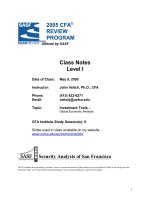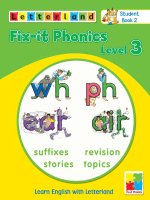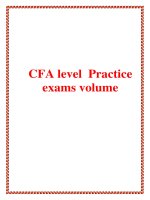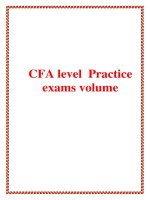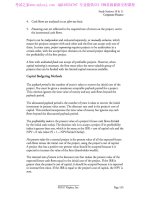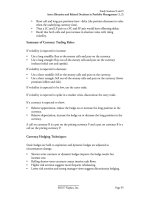CFA CFA level 3 CFA level 3 CFA level 3 CFA level 3 CFA volume 2 finquiz smart summary, study session 5, reading 12
Bạn đang xem bản rút gọn của tài liệu. Xem và tải ngay bản đầy đủ của tài liệu tại đây (130.38 KB, 8 trang )
2018 Study Session # 5, Reading # 12
“RISK MANAGEMENT FOR INDIVIDUALS”
1. INTRODUCTION
Overview of potential risks to indvs. & households
Analysis of products & strategies to protect against those risks
Selection of an appropriate product & strategy
2. HUMAN CAPITAL AND FINANCIAL CAPITAL
2. 2 Financial Capital
2. 1 Human Capital
Dominant asset on an indv.’s B/S.
Value of an indv.’s HC today at Time 0:
o Simple Model ܥܪ
Net wealth = Net worth + claims to future
assets that can be used for consumption
(e.g. HC & PV of pension benefits)
ௐ
= ∑ே
௧ୀଵ ሺଵାሻ
o Expanded Model ܥܪ
= ∑ே
௧ୀଵ
(ௌ )ௐషభ (ଵା )
(ଵା ା௬)
where Net worth = diff. b/w traditional
assets & liab.
Future payout on HC is uncertain as reality is more
complicated than models.
Later in lifecycle as HC diminishes,
o
Imp. of other risks ↑.
o
Imp. ↑ for strategies that reduce invst. risks,
protect against LT health-care exp. & long-life
spending needs
2.2.1
Personal
Assets
2. 3 Net wealth
HC = Human
Capital
FC = Financial
Capital
Indv. = Individual
Imp. = Importance
B/S = Balance
sheet
Mortg. = Mortgage
Invst. = Investment
LI = Life Insurance
Adj. = adjustment
DVA = deferred
variable annuity
IFA = Immediate
Fixed Annuity
Pmt. = Payment
Exp. = expense
2.2.6
Account
Type
2.2.2
Investment
Assets
2.2.3
Publicly
Traded
Marketable
Securities
Assets reflected on
traditional B/S.
Include money market
instruments, bonds, common
and preferred equity.
Their value and risk
characteristics are easier to
estimate.
2.2.5
NonMarketable
Assets
Varies materially
by countries but
Gen. are of three
types:
i. Taxable
ii. Tax-deferred
iii. Non-taxable
…continue
Assets (e.g. automobile,
furniture, clothes, personal
residence) consumed/used
by an indv.
Gen., not expected to
appreciate in value.
Often worth more to an indv.
than their fair/mkt. value.
[Mixed assets have both
personal & invst. features
e.g. real estate, jewelry,
artwork etc.]
2.2.4
Non-publicly
Traded
Marketable
Securities
Copyright © FinQuiz.com. All rights reserved.
1
2018 Study Session # 5, Reading # 12
2.2.4
Non-publicly Traded
Marketable Securities
2.2.4.2
Annuities
2.2.4.1
Real Estate
Among the largest
assets owned by
indvs.
Mortg. pmts.→often
the largest fixed
obligations of indvs.
Mortg. loans →
recourse or nonrecourse
Non-recourse loans
→riskier for lenders,
have ↑interest rates
&/or ↑borrower
credit standards.
2.2.4.3
Cash-value Life
Insurance
A private definedbenefit pension
guaranteed by an
insurance co. for
life/ over some
fixed period for
the beneficiary.
Combines life
insurance
protection with
some with some
type of cash
accumulation
vehicle.
2.2.5.1
Employer Pension Plans
(Vested)
1) Employee-directed Saving Plan⇒
contribution amount & invst. controlled by
indv.
2) Traditional Pension Plan⇒ guarantee some
retirement benefits
Value estimated by determining
mortality wghtd. NPV = mNPV0 =
= ∑ே
௧ୀଵ
2.2.5
Non-Marketable Assets
2.2.4.4
Business Assets
2.2.4.5
Collectibles
Indv’s (especially selfemployed) significant
portion of total wealth
Value estimated through
recent sales of comparable
businesses (multiple of NI
or EBITDA)
Value varies based on
market conditions.
E.g. stamps,
paintings, wine,
precious metals.
Value often set by
auction/specialized
dealers and involves
↑ transaction costs.
Also provide utility
for the owner.
2.2.5.2
Government Pensions
Similar to employer pension plan but are
more secure and considered as bond-like
However, country’s financial health, legal
framework and political stability matters.
(௦ )
(ଵା)
Estimating pension discount rate is complex
and should consider plan’s funded status,
credit quality and additional credit support
Copyright © FinQuiz.com. All rights reserved.
2
2018 Study Session # 5, Reading # 12
3. A FRAMEWORK FOR INDIVIDUAL RISK MANAGEMENT
3.1
The Risk Management
Strategy for Indvs.
3.2
Financial Stages of Life
3.4
Indv. Risk Exposures
3.3
The Indv. B/S
3.2.1
Education Phase
3.1.1. Step 1
Specify the objective
3.3.1
Traditional B/S
• Assets are
netted against
liab.
• Includes
recognizable
marketable
assets & liab.
• Ignores HC
and pension
benefits.
3.2.2
Early Career
3.1.2. Step 2
Identify Risks
3.2.3
Career Development
3.1.3. Step 3
Evaluate risks &
select appropriate
methods to
manage the risks
3.2.4
Peak Accumulation
3.2.5
Pre-retirement
3.1.4. Step 4
Monitor outcomes
& risk exposures &
make suitable adj.
in methods
3.2.6
Early Retirement
3.3.2
Economic
(Holistic) B/S
• Provides
indv’s overall
financial
condition
based on his
holistic
wealth.
• Economic B/S
+ PV of nonmarketable
assets (HC,
pensions) &
liab.
(consumption
needs,
bequests).
3.2.7
Late Retirement
•
•
•
•
3.4.1
Earning Risk
Major factors
include health,
unemployment,
underemployment
Self-employed or
professionals are
also prone to
earnings variability
May ↓ HC & FC.
Need to seek
additional training,
education, skills.
3.4.2
Premature Death
Risk
• Death of an
indv. earlier
than expected.
• ↓ HC and –vely
affect FC.
• For young
family the
effect can be
tragic.
• A risk to
consumption
needs also
occur if nonearning family
member dies.
•
•
•
•
3.4.3
Longevity Risk
Risks associated with
an extended
retirement period.
Significant impacts on
indv’s lifestyle even
when pension benefits
are substantial.
To calculate the sum
needed at retirement,
financial planners may
use:
i. Monte Carlo
Simulation
ii. Mortality Table
(adj. for health
factors)
Indv. concerned about
outliving his money
intends to work
longer, has ↑HC but at
possible exp. of less
desirable retirement
stage.
•
•
•
•
•
3.4.4
Property Risk
Loss that a
person’s property
may be lost, stolen,
damaged or
destroyed.
Direct
loss⇒property’s $
loss value
Indirect
loss⇒exps.
incurred for
property
repairment.
Causes loss of FC
Also cause loss of
HC specially when
property is used in
business to create
income.
Copyright © FinQuiz.com. All rights reserved.
•
•
•
•
3.3.3
Changes in Net
worth
Early in
Lifecycle→Tangible
assets dominate
indv.’s portf.
Later in Lifecycle
→Imp. of Nontraditional B/S
items ↑.
In early retirement
stage→Total
economic wealth is
dominated by
pension and real
estate.
Volatility in invst
portf. of Indv. with
↓ HC → ↑ impact on
variation in
expected
consumption.
3.4.5
Liability Risk
• Risk that an indv.
may be legally
liable for costs
associated with
property
damage/physical
injury.
• Major causes
involve
automobile
accidents;
homeowner’s
property may
cause injury to a
visitor/tenant.
• May affect an
indv’s FC &/or
HC.
3.4.6
Health Risk
• Related to
illness or injury.
• Significant
implications to
HC and FC.
3
2018 Study Session # 5, Reading # 12
4. INSURANCE & ANNUITIES
4.2
Disability Income
Insurance
On Next Page
4.2 Disability Income Insurance
• To mitigate earning risk as a
result of disability.
• Gen, insurance up to certain %.
• Other aspects include:
o
Benefit period
o
Elimination period
o
Rehabilitation clause
o
Waiver of premium
o
Option to purchase
additional rider
o
Non-cancelable &
guaranteed renewable
o
Non-cancelable policy
o
Inflation adj.
4.3
Property
Insurance
4.4
Health/Medical
Insurance
4.4 Health/Medical Insurance
• Highly dependent on countries
(some govts. fund health care)
• Two tiered System: Govt. coverage
+ upgraded coverage for more
pmt.
• In U.S. 3 types of insurance
approaches:
o Indemnity plan
o Preferred provider org. (PPO)
o Health maintenance org.
(HMO)
• Comprehensive major medical
insurance covers the vast majority
of health care exp.
• Key terms of most health
insurance plan includes:
•
Deductibles
•
Coinsurance
•
Copayments
•
Max. out of pocket exp.
•
Max. yearly benefit
•
Max. lifetime benefit
•
Preexisting conditions
•
Preadmission certification
• 4.3.1 Homeowner’s Insurance:
• Risks related to homeownership and personal
property & liability.
• Policies may be specified as “all risks”, include
all risks except those specified as “named risks”.
• To settle claim policy may be Replacement cost
(more expensive) or Actual Cash Value (cost less
dep.).
• If ↑deductible, then ↓Insurance premium
• Mortgage lenders require enough insurance to
cover the outstanding mortgage amount.
• Insurance co. want insurance at full value less
land value and losses are reimbursed at ↓rate if
home is underinsured.
• Homeowners’ liability risks are gen. addressed
within the insurance policy.
• Homeowner can use other risk management
techniques such as surveillance system, fire
extinguishers, bank’s safe deposit box, installing
surge protectors etc.
4.5
Liability
Insurance
4.6
Other Types
of Insurance
4.5 Liability
Insurance
• If liability
coverage in the
homeowner’s
and automobile
insurance is less
than one think
is appropriate.
• Personal
umbrella policy
(relatively
inexpensive)→
pays claims if
liability limit of
homeowner’s
or automobile
policy is
exceeded.
4.6 Other Types of
Insurance
• Depending on the
indv. situation.
• Title insurance
(when purchasing a
home, to make
sure ownership of
the property is not
in doubt)
• Service contracts
(extended
warranty) →when
purchasing
automobile, home
appliances,
sizeable products
to avoid repair
cost.
• 4.3.2 Automobile Insurance:
• Insurance rates are primarily based on vehicle
value and driver’s age & driving record.
• Two parts of Coverage of damage
i. Collision Coverage (for damage from
accident)
ii. Comprehensive Coverage (for damage from
other sources glass, breakage, hail, theft)
• There may also be coverage available if vehicle is
damaged by uninsured/underinsured and
passengers’ medical coverage.
• If repair cost > actual cash value insurance
companies reimburse only the actual cash value.
• Liability risks (body injury, property damage) is
gen. covered within the policy.
• Indvs. can use other safe driving techniques such
as wearing seat belts, avoiding extreme weather,
backup camera, lane-change warning system etc.
Copyright © FinQuiz.com. All rights reserved.
4.7
Annuities
On Page 6
4.1
Life Insurance
(LI)
4
2018 Study Session # 5, Reading # 12
4.1
Life Insurance (LI)
•
•
•
•
4.1.1
Uses of LI
Provides hedge
against earner’s
death.
Imp. estate
planning
tool→provides
immediate
illiquidity to
beneficiary.
A tax-sheltered
saving tool.
As mortality risk
↑, mortality
charge ↑.
4.1.4.1
Mortality
Expectations
• Are based
on historical
data &
future
expectations
• Actuaries
make adj. to
general
mortality
table based
on factors
(e.g. health
history,
smoking,
excess
weight etc.)
• Large
policies may
require
physical
examination
.
4.1.2
Types of LI
1. Temporary LI (TLI)
• For certain specified time period
• Premium either remain level or ↑ over time.
• Cost is less than PLI
2. Permanent LI (PLI)
• Life time coverage
• Usually fixed policy premiums.
• May have non-forfeiture clause (e.g. cash
surrender option, reduced paid up option,
extended term option)
• Several types (e.g. whole LI, universal LI)
Whole LI:
Universal LI:
• Remains in force for an • More flexible
insured’s whole life.
• Insured can pay
↑ ↓ ݎpremium
• Cash value is associated
• Non-cancelability
• More options for
feature appeals
investing the
younger indvs.
cash value.
• Participating (benefits
∆ due to co.’s profits)
or Non-participating
(fixed value).
Common features of TLI & PLI
• Non-cancelable
• Potential riders can be added (e.g. accidental
death & dismemberment AD&D, accelerated
death benefit, guaranteed insurability, waiver
of premium).
• Viatical settlement (option to sell the premium
to a 3rd party)
•
•
•
•
•
4.1.4.2
Calculation of the Net/Gross Premium
Net Premium of LI policy is the discounted
value of future death benefits
Gross premium adds a load to the net
premium.
Level Term Policies: Premiums are ↑in
early yrs. and ↓ in later yrs.
Annually Renewable Policies: consumers
have advantage of ‘loss leader’ but health
issue or accident can make indv.
uninsurable.
Two groups of Life Insurers:
i. Stock Companies.
• Owned by shareholders
• Have a profit motive
• Add projected profit as a part of load
in pricing policies
ii. Mutual Companies
•
Owned by policy owners
•
No profit motive
•
Charge a gross premium, which is
↑than net premium + expenses.
This extra amount is paid back to
policy owner as a policy dividend.
4.1.3
Basic Elements of LI Policy
• Term, type of policy
• Amount. of benefits
• Limitations (to withhold
benefits)
• Contestability period
• Identity, policy owner
• Beneficiaries
• Premium schedule
• Riders (if any) to the policy
• insurable interest
• 4 primary parties:
i. insured
ii. policy owner
iii. beneficiary
iv. insurer
• documentation/proof of
death
4.1.4.3
Cash value & Policy
Reserves
• In Whole LPs:
i. Premium →
stays constant
ii. Face value →
stays constant
iii. Cash value →↑
iv. Insurance
value →↓
• Cash value can be
1) withdrawn
when policy
terminate or 2)
can be borrowed
as a loan.
• Life insurers are
required by
regulators to
maintain policy
reserves.
4.1.4
How
LI is
Price
d
4.1.5
How Much LI
Does One
Need?
• Vary from
person to
person and
based on the
no. of
dependents
• Primary
purpose: to
replace PV of
future
earnings.
• Other factors
include:
immediate
financial exp.
& legacy
goals.
4.1.4.4
Consumer Comparisons of LI Costs
Two popular indexes for comparison are:
1) Net pmt. cost index
2) Surrender cost index
Calculation Comparison
(assuming 5% discount rate & 20-yr. period
Steps Net Pmt. Cost Index
Surrender Cost Index
Assumes insured
Assumes policy will be
person will die at
surrendered at period
period end.
end & policy owner
will receive the
projected cash flow.
A
Calculate FV of
Same
Annuity Due of
Premium
B
Calculate FV of
Same
ordinary annuity of
projected annual
dividends
C
20-yr. Insurance
20-yr. Insurance Cost =
Cost = A-B
A-B-20 yr. projected
Cash Value
D
Interest adj. cost
Same
per yr. = Calculate
Pmts. for 20-yr.
annuity due with FV
equal to C.
E
Divide D by # of
Same
thousand dollars of
face value.
Copyright © FinQuiz.com. All rights reserved.
5
2018 Study Session # 5, Reading # 12
4.7 Annuities
4.7.1 Parties to
an Annuity
Contract
Four primary
parties:
i. Insurer
ii. Annuitant
iii. Contact
owner
iv. Beneficiary
4.7.2
Classification
of Annuities
4.7.3.1 Volatility of
Benefit Amount
• Retirees seeking ↑
level of assurance of
benefit payouts
select fixed annuity
or variable annuity
that limits ∆ in
benefit over time.
• Risk tolerant retirees
→ opt. for variable
annuity.
4.7.3 Advantages &
Disadvantages of
Fixed & Variable
Annuities
Imp. considerations
when selecting
fixed/variable
annuities.
4.7.3.2 Flexibility
• IFA (gen. irrevocable)
offer guarantee of
income for life.
• Variable annuities
(market
performance based)
provide guaranteed
income and flexibility
to access the funds.
4.7.4 Payout Methods
• Gen. similar for fixed or
variable annuities
• Life Annuity: Pmt. For
annuitant’s entire life and
cease at his death.
• Period-certain Annuity: Pmts.
for certain # of periods without
regard to lifespan.
• Life Annuity with period
certain: Pmts. for annuitant’s
entire life but guaranteed min.
# of yrs. even if he dies.
• Life Annuity with refund:
similar to life annuity with
period certain but guaranteed
pmt. = initial invst. – fees
• Joint Life Annuity: Pmt.
Continue until two/more
members are no longer living.
• Payout methods are not
mutually exclusive and
frequencies may vary (e.g.
monthly, quarterly etc.)
4.7.3.3 Future Market
Expectations
Fixed Annuities: (bond-like
assets)
• have interest rate risk
• Annuitant receives only
market return on invst.
• no mortality credit
Variable Annuities:
• possibility of ↑ future
pmts. in up market
• ↑ market risk and have
mortality credit
Copyright © FinQuiz.com. All rights reserved.
4.7.5 Annuity
Benefit Taxation
• Can offer
attractive tax
benefits (e.g.
in U.S. offer
tax deferred
growth).
• Actual tax
method varies
by countries.
4.7.3.4 Fees
Variable Annuities:
• ↑ fees
• opaque pricing
cause reduced
price
competition.
Fixed Annuities:
• ↓ fees
• much easier to
compare
4.7.6
Appropriateness
of Annuities
• Annual
benefit pmt.
can be
decomposed
into i) interest
ii) return of
premium iii)
mortality
credit.
• How much
annuitize
→depends on
indv’s
preference for
wealth max. &
longevity risk
aversion.
4.7.3.5 Inflation
Concerns
• Inflation can
affect real
income of fixed
annuities
• No. of variable
annuities and
riders of fixed
annuities allow
↑ ↓ ݎin pmts.
due to ∆in
inflation.
6
2018 Study Session # 5, Reading # 12
4.7.2.1 Deferred Variable Annuities (DVA)
• Similar to mutual funds
• Indvs. can choose from a menu of potential invst. options.
• Compared with mutual funds DVA are ↑expensive and have ↓invst.
options.
• May include a death benefit (valuable to beneficiary when
contract value < initial invst.)
• Indv. have the right to exit (sell) the contract
• DVA does not guarantee lifetime income unless the indv. 1)add
contract rider →guaranteed min. pmt or 2) annuitize the contract
by converting DVA into immediate payout annuity (few investors
choose to annuitize).
4.7.2 Classification of Annuities
• Two most critical dimensions
to classify are:
1. Deferred vs immediate
2. Fixed vs variable
• Joint life annuity (based on
expected life span of two
annuitants)
4.7.2.2 Deferred Fixed Annuities (DFA)
• Fixed annuity payout that begins at some future date.
• Less costly for young indvs.
• Prior to annuitization, investor can cash out and receive eco. value
less surrender charges.
• After retirement indv. has 2 options
i. Cash out
ii. Begin fund withdrawal
• Most deferred fixed annuities are eventually annuitized
4.7.2.3 Immediate Variable Annuities (IVA)
• Lump sum is exchanged for an annuity (income for life)
• Pmt. varies based on the portfolio performance.
• Income floor feature can be added for protection in down market.
4.7.2.4 Immediate Fixed Annuities (IFA)
• Indvs. trade a sum of money today for promised life long income
benefit.
௧௧௨
• Income yield (payout) =
௧௨௦
• Payouts are ↑, when expected remaining longevity is shorter (i.e.
payout is ↑ for 85-yr.old compared to 65-yr. old).
• For same age, male has ↑payout than female.
• Annuity pricing is affected by mortality and expected return
insurance co. earn on premium.
• Payout will be ↓ if current bond yields are ↓and life expectancy is ↑
4.7.2.5 Advanced Life Deferred Annuities (ALDA)
• Hybrid of deferred fixed (DFA) and immediate fixed annuity (IFA).
• Refereed to pure longevity insurance.
• Permanent exchange of lump sum for income (like IFA) but pmt.
begin immediately (unlike IPA).
• Cost ↓ than regular immediate life annuity bcz. fewer pmts. that
begin far in the future.
Copyright © FinQuiz.com. All rights reserved.
7
2018 Study Session # 5, Reading # 12
5. IMPLEMENTAION OF RISK MANAGEMENT FOR INDIVIDUALS
5.1 Determining the
Optimal Risk
Management Strategy
• Depends on household’s
risk tolerance
• 3 approaches to loss
control
i. Risk avoidance
(remove loss event
possibility)
ii. Loss prevention
(taking actions to ↓
probability of loss
event)
iii. Loss reduction (↓
the size of loss)
• Indvs. can manage risk
through techniques of:
i. Risk transfer
(insurance/ noninsurance transfers)
ii. Risk retention
• Systematic risk mgmt.
approach →consider the
optimal strategy for each
risk exposure
5.2 Analyzing an
Insurance Program
i. Current Insurance
Plan
ii. Program Review
iii. Recommendations
5.3 The Effect of
Human Capital (HC) on
Asset Allocation Policy
• Indv’s. total economic wealth affects
portfolio construction through:
a.
Asset allocation
b. Underlying asset classes
• Gen. HC is bond-like
• No hedging benefits → if asset
performance is correlated with indv’s
earnings
• Within occupation each indv. has
different HC risks (job loss impact on
long-term HC, Health shock etc.).
• Overall riskiness of HC is ↓ if:
o both spouses are employed
(unless their HC is highly
correlated).
o non-working spouse can rejoin
work force.
• Overall riskiness of HC is ↑:
o if HC is tied to specific
geographic location.
o if HC is vulnerable to
disability/premature risk
o if HC is very employer-specific.
o for Professions with ↑ income
variance
• Optimal invst. policy→forms a target
mix of risky vs. risk-free assets, based
on risk-tolerance & adj. for ∆ in assets
values over time:
Copyright © FinQuiz.com. All rights reserved.
5.4 Asset
Allocation & Risk
Reduction Policy
• Mainly to smooth spending over
time.
• Invst. risk, property risk & HC risk
can be either idiosyncratic or
systematic.
• Idiosyncratic risks include:
o
Specific occupation risk
o
Longevity risk
o
Pre-mature death risk
o
Long-term illness
o
Property loss
• Idiosyncratic HC risks can be
reduced through invst. portfolio
strategies & insurance products.
• Systematic risks include:
o
Overall market
performance
o
Economic condition
o
Overall longevity due to
healthcare
improvements
• Systematic risks affect all
households.
8

